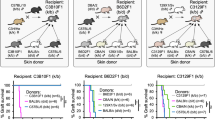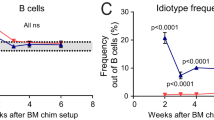Abstract
ANTIGENS coded for by the H–2K, H–2D and H–2I region of the major histocompatibility complex (MHC) of the mouse initiate different in vitro responses. I region-coded antigens activate mainly Lyt 1+ T cells to produce a proliferative response in mixed lymphocyte cultures (MLC), whereas K and D region-coded antigens predominantly stimulate Lyt 2+ T cells to become cytolytic effector cells1. Proliferative responses in MLC and generation of cytolytic T cells in vitro can also be induced by minor histocompatibility antigens. For example, Mls-locus products can induce positive MLC responses, but not the generation of cytolytic T cells2, whereas H–Y antigen does give rise to anti-H–Y cytotoxic T-cell responses in vitro, following in vivo priming3. Functional in vivo studies have shown that H–2K, H–2D and H–2I differences can account for graft rejection4 and for mortality in graft-versus-host (GvH) reactions5. Differences in only minor histocompatibility antigens are sufficient to cause graft rejection6, and lethal GvH reaction after allogeneic bone marrow transplantation7. Similarly, immunisation with only H–2 or only non-H–2 antigens can induce a state of delayed-type hypersensitivity (DTH) to the immunising antigen, which can be measured with the footpad swelling test8. So far, such in vivo experiments have shown little or no discrimination between responses to H–2 subregion antigens and responses to non-H–2 antigens. We have used a DTH assay to study the occurrence of T-effector cells after in vivo immunisation with different histocompatibility antigens. We show here that DTH T-effector cells generated in GvH and host-versus-graft (HvG) reactions are specific for largely different sets of histocompatibility antigens, with selective stimulation by H–2I and Mls-locus antigens in GvH conditions.
This is a preview of subscription content, access via your institution
Access options
Subscribe to this journal
Receive 51 print issues and online access
$199.00 per year
only $3.90 per issue
Buy this article
- Purchase on Springer Link
- Instant access to full article PDF
Prices may be subject to local taxes which are calculated during checkout
Similar content being viewed by others
References
Bach, F. H., Bach, M. L. & Sondel, P. M. Nature 259, 273–281 (1976).
Festenstein, H. in Immunobiology of Bone Marrow Transplantation (eds Dupont, B. & Good, R. A.) 13–21 (Grune and Stratton, New York, 1976).
Simpson, E. & Gordon, R. D. Immun. Rev. 35, 59–75 (1977).
Klein, J. in Biology of the Mouse Histocompatibility-2 Complex, 151–177 (Springer, Berlin, 1975).
Klein, J. & Chiang, C. L. J. Immun. 117, 736–740 (1976).
Graff, R. J. & Bailey, D. W. Transplantn Rev. 15, 26–49 (1973).
Korngold, R. & Sprent, J. J. exp. Med. 148, 1687–1698 (1978).
Kon, N. D. & Klein, P. A. J. Immun. 117, 413–415 (1976).
Wolters, E. A. J. & Benner, R. Transplantation 26, 40–45 (1978).
Wolters, E. A. J. & Benner, R. Transplantation 27, 39–42 (1979).
Bevan, M. J. J. exp. Med. 142, 1349–1364 (1975).
Vadas, M. A., Miller, J. F. A. P., Whitelaw, A. M. & Gamble, J. R. Immunogenetics 4, 137–153 (1977).
Ford, W. L., Simmonds, S. J. & Atkins, R. C. J. exp. Med. 141, 681–696 (1975).
Lindahl, K. F. & Wilson, D. B. J. exp. Med. 145, 508–522 (1977).
Wolters, E. A. J., Brons, N. H. C., Van der Kwast, T. H. & Benner, R. (in preparation).
Author information
Authors and Affiliations
Rights and permissions
About this article
Cite this article
WOLTERS, E., BENNER, R. Functional separation in vivo of both antigens encoded by H–2 subregion and non-H–2 loci. Nature 279, 642–643 (1979). https://doi.org/10.1038/279642a0
Received:
Accepted:
Issue Date:
DOI: https://doi.org/10.1038/279642a0
This article is cited by
-
Restricted recognition of H-2 subregion coded alloantigens in delayed-type hypersensitivity
Immunogenetics (1984)
-
Alloantigen-specific suppressor T cells can also suppress the in vivo immune response to unrelated alloantigens
Nature (1983)
-
Different target antigens for T-cell subsets acting synergistically in vivo
Nature (1980)
Comments
By submitting a comment you agree to abide by our Terms and Community Guidelines. If you find something abusive or that does not comply with our terms or guidelines please flag it as inappropriate.



